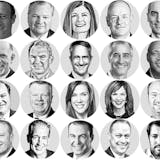Like the displaced people themselves, this week's news about the global migration crisis just kept coming.
On Sunday, Spain's new socialist government accepted about 600 hungry, exhausted migrants after Italy's new right-wing government denied the desperate diaspora.
They'd been saved from flimsy dinghies by the rescue ship Aquarius, a name that may conjure a '60s sensibility. But regarding migration, the dawning of this new age is less hippie and more unhappy.
This is true most everywhere, but particularly in Europe, where waves of Mediterranean migrants have resulted in an undertow of populism that threatens even leaders like Angela Merkel, the German chancellor challenged by factions within her own party, not to mention rival right-wing movements. On Monday, Merkel bought a two-week reprieve as European leaders meet on the metastasizing migration and political crises. But elusive consensus may mean the continent's most consequential leader's coalition government could collapse.
On Tuesday, the U.N.'s Refugee Agency gave quantitative context to the issue when it reported that by the end of 2017, 68.5 million people — or one of every 111 humans worldwide — were displaced due to "wars, violence, persecution" and other factors.
And on Wednesday — World Refugee Day — President Donald Trump reversed his controversial policy on child separation at America's southern border but pledged at a Duluth rally that "the border is going to be just as tough as it has been."
Border boasts are increasingly heard worldwide as regimes respond to rising public pushback. But disruptive, even destructive transnational factors spanning multiple flailing or failing states mean unmitigated migration is likely to continue.
"We are at a watershed, where success in managing forced displacement globally requires a new and far more comprehensive approach so that countries and communities aren't left dealing with this alone," U.N. High Commissioner for Refugees Filippo Grandi said in the sobering report from the U.N.


